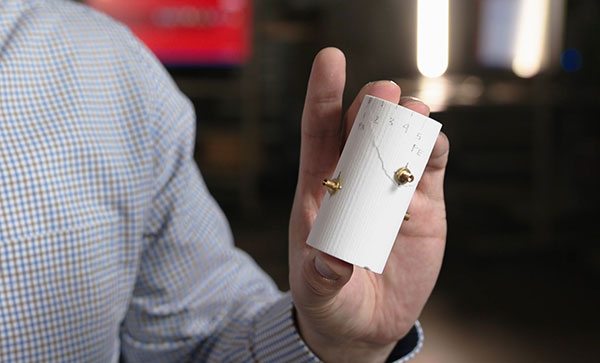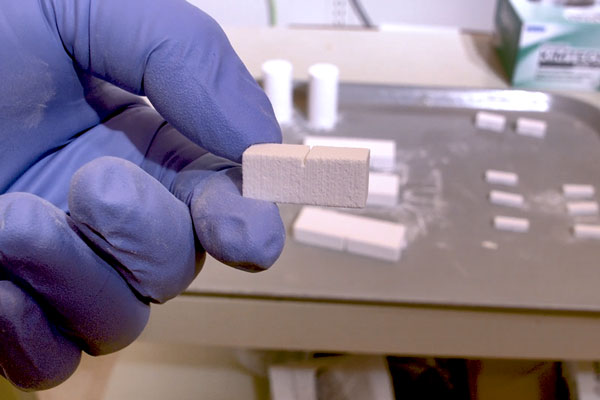
Sandia geoscientists used 3D-printed rocks and an advanced, large-scale computer model of past earthquakes to understand and prevent earthquakes triggered by energy exploration.
Injecting water underground after unconventional oil and gas extraction, or fracking, geothermal energy stimulation and carbon dioxide sequestration all can trigger earthquakes. Of course, energy companies do their due diligence to check for faults — breaks in the earth’s upper crust that are prone to earthquakes — but sometimes earthquakes, even swarms of earthquakes, strike unexpectedly.
Sandia geoscientists studied how pressure and stress from injecting water can transfer through pores in rocks down to fault lines, including previously hidden ones. They also crushed rocks with specially engineered weak points to hear the sound of different types of fault failures, which will aid in early detection of an induced earthquake.
3D printing reveals structural information
To study different types of fault failures and their warning signs, Sandia geoscientist Hongkyu Yoon needed a bunch of rocks that would fracture the same way each time he applied pressure — pressure not unlike the pressure caused by injecting water underground. Natural rocks collected from the same location can have vastly different mineral orientation and layering, causing different weak points and fracture types.
Several years ago, Hongkyu started using additive manufacturing, or 3D printing, to make rocks from a gypsum-based mineral under controlled conditions, believing that these rocks would be more uniform. To print the rocks, Hongkyu and his team sprayed gypsum in thin layers, forming 1-by-3-by-half inch rectangular blocks and cylinders.
However, as he studied the 3D-printed rocks, Hongkyu realized that the printing process also generated minute structural differences that affected how the rocks fractured. This piqued his interest, leading him to study how the mineral texture in 3D-printed rocks influences how they fracture.
“It turns out we can use that variability of mechanical and seismic responses of a 3-D printed fracture to our advantage to help us understand the fundamental processes of fracturing and its impact on fluid flow in rocks,” Hongkyu said. This fluid flow and pore pressure can trigger earthquakes.
For these experiments, Hongkyu and collaborators at Purdue University, with which Sandia has a longstanding partnership, made a mineral ink using calcium sulfate powder and water. The researchers, including Purdue professors Antonio Bobet and Laura Pyrak-Nolte, printed a layer of hydrated calcium sulfate about half as thick as a sheet of paper, and then applied a water-based binder to glue the next layer to the first. The binder recrystallized some of the calcium sulfate into gypsum, the same mineral used in construction drywall.
The researchers printed the same rectangular and cylindrical gypsum-based rocks. Some rocks had the gypsum mineral layers running horizontally, while others had vertical mineral layers. The researchers also varied the direction in which they sprayed the binder, to create more variation in mineral layering.
The research team squeezed the samples until they broke and then examined the fracture surfaces using lasers and an X-ray microscope. They noticed the fracture path depended on the direction of the mineral layers. Hongkyu and colleagues described this fundamental study in a paper published in the journal Scientific Reports.
Classifying seismic events with sound
Working with his collaborators at Purdue, Hongkyu monitored acoustic waves coming from the printed samples as they fractured. These sound waves are signs of rapid microcracks. Then the team combined the sound data with machine-learning techniques, a type of advanced data analysis that can identify patterns in seemingly unrelated data, to detect signals of minute seismic events.
First, Hongkyu and his colleagues used a machine-learning technique known as a random forest algorithm to cluster the microseismic events into groups that were caused by the same types of microstructures and identify about 25 important features in the microcrack sound data. They ranked these features by significance.
Using the significant features as a guide, they created a multilayered “deep” learning algorithm — like the algorithms that allow digital assistants to function — and applied it to archived data collected from real-world events. The deep-learning algorithm was able to identify signals of seismic events faster and more accurately than conventional monitoring systems.
Hongkyu said that within five years they hope to apply many different machine-learning algorithms, including those with imbedded geoscience principles, to detect induced earthquakes related to fossil fuel activities in oil or gas fields. The algorithms also can help detect hidden faults that might become unstable due to carbon sequestration or geothermal energy stimulation, he said.
“One of the nice things about machine learning is the scalability,” Hongkyu said. “We always try to apply certain concepts that were developed under laboratory conditions to large-scale problems — that’s why we do laboratory work. Once we proved those machine-learning concepts developed at the laboratory scale on archived data, it’s very easy to scale it up to large-scale problems, compared to traditional methods.”
Stress transfers through rock to deep faults
A hidden fault was the cause of a surprise earthquake at a geothermal stimulation site in Pohang, South Korea. In 2017, two months after the final geothermal stimulation experiment ended, a magnitude 5.5 earthquake shook the area, the second strongest quake there in recent history.
After the earthquake, geoscientists discovered a fault hidden deep between two injection wells. To understand how stresses from water injection traveled to the fault and caused the quake, Kyung Won Chang, a geoscientist at Sandia, realized he needed to consider more than the stress of water pressing on the rocks. In addition to that deformation stress, his complex computational model also needed to account for how that stress transferred to the rock as the water flowed through pores in the rock itself.
Kyung Won and his colleagues described the stress transfer in a paper published in the journal Scientific Reports.
However, understanding deformation stress and transfer of stress through rock pores is not enough to understand and predict some earthquakes induced by energy-exploration activities. The architecture of different faults also needs to be considered.
Using his model, Kyung Won analyzed a cube 6 miles long, 6 miles wide and 6 miles deep where a “swarm” of more than 500 earthquakes took place in Azle, Texas, from November 2013 to May 2014. The earthquakes occurred along two intersecting faults, one less than 2 miles beneath the surface and another longer and deeper. While the shallow fault was closer to the sites of wastewater injection, the first earthquakes occurred along the longer, deeper fault.
In his model, Kyung Won found that the water injections increased the pressure on the shallow fault. At the same time, injection-induced stress transferred through the rock down to the deep fault. Because the deep fault was under more stress initially, the earthquake swarm began there. He and Hongkyu shared the advanced computational model and their description of the Azle earthquakes in a paper recently published in the Journal of Geophysical Research: Solid Earth.
“In general, we need multiphysics models that couple different forms of stress beyond just pore pressure and the deformation of rocks to understand induced earthquakes and correlate them with energy activities, such as hydraulic stimulation and wastewater injection,” Kyung Won said.
Kyung Won said he and Hongkyu are working together to apply and scale up machine-learning algorithms to detect previously hidden faults and identify signatures of geologic stress that could predict the magnitude of a triggered earthquake.
In the future, Kyung Won hopes to use those stress signatures to create a map of potential hazards for induced earthquakes around the United States.
His research effort, as well as Hongkyu’s initial work, were funded by Sandia’s Laboratory Directed Research and Development.
Cracking rocks to catch quakes
Sandia geoscientist Hongkyu Yoon and his team 3D print rocks with reproducible faults and then squeeze them until they crack. Listening to the sound of the rocks breaking provided the team with the data they needed to “train” a deep-learning algorithm to identify signals of seismic events faster and more accurately than conventional earthquake monitoring systems. View the video (all video footage was taken prior to the COVID-19 pandemic).
